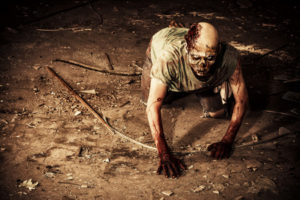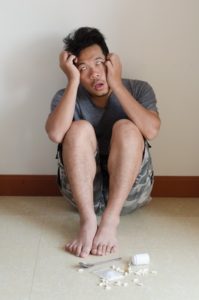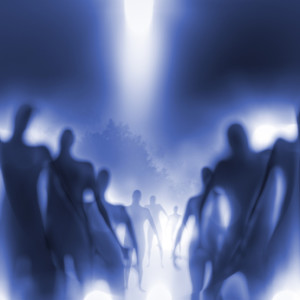Zombie Drug

Flakka was big news 18 to 24 months ago, with Broward County in Florida as ground zero. People were stripping themselves naked and running through traffic; trying to break INTO police substations; impaling themselves on iron fences and other sorts of mayhem. Others were grunting and moaning incoherently; and still others were catatonic, earning flakka the nickname of “the zombie drug.” After China banned the manufacture and export of alpha-PVP (the chemical name for flakka) in early 2016, it seemed to quickly fade from the news. But like all good zombie stories, flakka seems to have risen from the dead.
The website Lovin Malta reported flakka has made its way to Malta, an island country in the Mediterranean Sea. A forensic chemist said: “Flakka has been circulating across Europe and it has definitely found its way southwards to Malta too, as is the trend for many drugs.” He couldn’t confirm if anyone had overdosed on it, or if police made any arrests, “but it is definitely here.” The Malta Police Force confirmed with Lovin Malta there was a suspected case of flakka in 2015, but they could not prosecute or arrest the person, because flakka is not an illegal substance in Maltese law. Read the Lovin Malta reports here and here.
On October 17, 2016, Carrie-Anne Greenbank reported for 9 News Queensland that flakka was thought to be responsible for a mass overdose on the Gold Coast. One person was in a two day induced coma after being given the suspected drug at the Sin City Nightclub on the Gold Coast of Australia. He had acute kidney failure, 2-3 seizures and wasn’t able to stomach even water. He was one of sixteen who overdosed and were taken to a hospital. Annastacia Palaszczuk, the Premier of Queensland, Australia, said: “Do not put your life at risk. It is not worth it.” See the video report on the 9 News Queensland Facebook page, here.
Another 9 News report on November 11, 2016 had a short video clip of a Queensland man suspected of suffering from a flakka overdose. He was screaming and resisting the restraint of eight ambulance workers. The report also mentioned Shelbi, a 24 year-old woman from Los Angeles who last used flakka nine months before, in February of 2016. Shelbi was on an episode of the TV series, Intervention, where she was filmed beginning a sentence and then completely losing her focus, unable to continue. She said: “The last time I used flakka was nine months ago, and still to this day… Huh?”
An April 3, 2017 story by The National, a Middle East English-language news service, reported that after advice from the Dubai Police, the Ministry of Health recommended that flakka and cathinone be added to the list of banned mind-altering illegal substances in the UAE, the United Arab Emirates. Flakka wasn’t found in Dubai or the UAE, so the action is a pre-emptive one. Dr. Amin Al Amiri, chairman of the narcotic review committee, said the law needed to be revised so it could keep up with new challenges, like flakka. “We are adding it after making sure it belongs in the law.”
Colonel Eid Hareb, director general of the anti-narcotics department, said: “We have not had any flakka cases or what they call ‘zombie cases’ here in Dubai or in the UAE, but we do not want it to come here. . . . We don’t want people to use this drug, that is why we put it on the list.” Anyone caught using flakka or cathinone in the UAE could face at least two years in prison. If someone is found guilty of trafficking the substances, they could get the death penalty.
The Indonesia Expat has a May 31, 2017 story about flakka that said flakka was suspected of coming into Indonesia. The Head of the National Narcotics Agency, Budi Waseso, told reporters in South Jakarta that the agency was investigating the report. There was a review on May 15-16, and the analysis was submitted to the Ministry of Health. It recommended that alpha-PVP be placed as a Group 1 substance in the annex of the Narcotics Act.
In case you didn’t check out any of the flakka YouTube videos or read any of the news stories on the drug in 2015 or 2106, here is a short flakka primer drawn from a psychiatric case report, “Flakka-Induced Prolonged Psychosis,” a Psychiatric Times article, Flakka: A Deadly High” and a World Health Report. Drug effects from flakka can last one hour, several hours, or several days. Users may seem to have “super human strength,” be very agitated or even comatose.
The primary ingredient is pyrrolidinopentiophenone (alpha-PVP), a synthetic cathinone. It is an analogue of prolintane, which inhibits norepinephrine-dopamine reuptake, meaning it acts like a stimulant. Flakka is 10 to 20 times more potent than cocaine and MDPV (methylenedioxypyrovalerone), an ingredient in bath salts. You can smoke, snort, vape, inject or use it sublingually (under the tongue). It enters the bloodstream very quickly and has a serious risk of overdose.
It is known to provoke a condition called agitated delirium, causing bizarre behaviors, anxiety, agitation, violent outbursts, confusion, myoclonus (muscles twitches and jerks), and rare cases of seizures. Individuals with agitated delirium from flakka use can hallucinate and be violent, aggressive and paranoid. Self-injury and suicidal tendencies have been reported as well. “Clinical symptoms of agitated delirium involve tachycardia [abnormally rapid hear rate], hypertension [abnormally high blood pressure], hyperthermia [abnormally high body temperature], diaphoresis [excessive, abnormal sweating], and mydriasis [pupil dilation].” Multiple fatalities have been reported with flakka.
The WHO Report recommended placing flakka under international control as a Schedule II controlled substance. The WHO Schedule II is for substances whose liability for abuse constitutes a substantial public health risk and which have very little if any therapeutic value. It also indicated multiple member states have taken measures to curb the misuse of alpha-PVP.
Fifteen member states of the EMCDDA (Estonia, Finland, France, Germany, Greece, Hungary, Ireland, Italy, Latvia, Lithuania, Poland, Romania, Slovenia, Sweden, and the United Kingdom) as well as Turkey and Norway reported that alpha-PVP is controlled under drug control legislation. Four member states (Austria, Cyprus, Portugal and Slovakia) reported alpha-PVP is controlled under drug control legislation prohibiting the unauthorized supply of defined or qualifying new psychoactive substances. Other two member states (Belgium and Czech Republic) started the process of controlling the substance using drug control legislation. In the United State of America, alpha-PVP has been temporarily scheduled into schedule I pursuant to the temporary scheduling provisions of the Controlled Substance Act (CSA). In Japan, alpha-PVP has been controlled under the Narcotics and Psychotropics Control Act.
The psychiatric case report described a 17 year-old girl with no prior history of psychiatric diagnosis and who was never previously seen by a mental health professional. She was involuntarily committed to a psychiatric hospital after being transferred from a local Emergency Department “for altered mental status with agitation and psychotic behaviors, including auditory hallucinations.” She was treated with olanzapine (Zyprexa) and lorazepam (Ativan) for agitation. At first, she was bizarre and illogical and needed staff assistance with activities of daily living.
During the initial evaluation, she was drowsy and incoherent; unable to give an accurate history of the events leading up to her altered state. According to her mother, she was alone in her bedroom yelling, “Go away!” The mother said she was not sleeping and has no history of nightmares or sleep terrors. Her bizarre, disorganized and psychotic behavior continued through the fifth day of her hospitalization. She had mentioned she might have taken flakka, but was vague about the circumstances.
Finally, on day six, the patient became coherent, alert and oriented to person, place, time, and situation, and capable of completing her activities of daily living. She remained somewhat constricted and at times required redirection and instructions to complete tasks. When asked about her symptoms for the past week, she described an incident that happened at school the day before being admitted to the hospital. She claims that a group of her “friends” were pressuring her to try Flakka with them. Although she refused, she believes that they put some on the food she was eating because she claimed it tasted funny and felt weird ever since. She also denies any recent major stressors or traumatic events that could have led to her behaviors. After one more day of observation, the patient did not display any more overt psychotic symptoms and was discharged home with the appropriate scheduled outpatient appointments.
The reported circumstances for how she ingested flakka seem suspect to me. I’d guess she tried flakka voluntarily, perhaps under pressure from her friends. The sweaty socks smell with flakka would be the signal not to eat the food. Left unsaid in the case report, but more than likely, the girl would have continued to take her medications after discharge; at least the antipsychotic olanzapine. Although she didn’t have any “overt” psychotic symptoms at the time of her discharge she continued: “to have residual symptoms including psychomotor agitation and slowing of cognition.” (Hmmm… Could these symptoms be side effects from the medication?) A bad trip with flakka seems to have started her on a journey through the world of psychiatric treatment, with its own series of complications. Would she have gone there without the flakka? It’s hard to tell.
I’ve written previously about flakka on this website; and you can read those articles, which are linked here: “Fading Flakka Fad,” “High on Flakka,” and “Flack from Flakka.” You can also read about potential problems with psychiatric medications here: “Antipsychotic Big Bang,” Worse Results with Psych Meds,” and “Blind Spots with Antipsychotics,” Part 1 and Part 2. There are several additional articles on the concerns with psychiatric medications.


